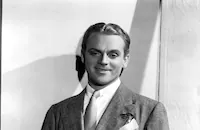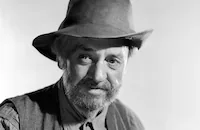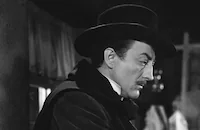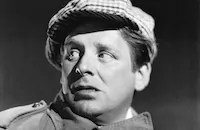Set during the late 1920s,
Blood on the Sun (1945) stars James Cagney as Nick Condon, editor of an English-language newspaper in 1920s Tokyo. He discovers a Japanese military plan to conquer China, the United States and the world - the "Tanaka Plan." With the help of beautiful Chinese-American spy Iris Hilliard (Sylvia Sidney), Condon steals the plan and tries to take it out of the country and reveal it to the world, all the while being pursued by Japanese authorities.
The story is based on fact. The Tanaka Plan was a real document stolen in 1927 and exposed in the international press, originally by a Chinese newspaper. (Japan dismissed it as a forgery, and no one else did anything about it.) The facts end there, however, as
Blood on the Sun is mainly an action-packed Cagney vehicle which earned over $1 million profit at the box office and received decent notices. "As melodrama," wrote
Time, "it is as hard, tidy and enjoyable as the work of its star James Cagney, the dean of the sort of movie in which action and good sense collaborate instead of colliding. He cannot even put a telephone receiver back on its hook without giving the action special spark and life."
The New Yorker emphasized the action, declaring wryly, "it is the most violent workout Mr. Cagney has had since
[The] Public Enemy [1931], and it ought to be fine for those who admire a good, ninety-minute massacre."
The fight scenes in
Blood on the Sun all involve judo. Cagney trained in the art extensively and even kept it up in his private life, writing in his memoirs, "I grew so fond of judo I used to keep in shape with it until a back injury I picked up doing something else put me on the sidelines." Cagney's judo instructor was a former L.A. cop named John Halloran, who in the film has a small role as Japanese "Captain Oshima."
(In a sign of the paranoia of wartime America, Halloran resigned from the LAPD after the police commission sent FBI agents to investigate him because his favorite sport was judo.)
Blood on the Sun was the second picture that James Cagney and his brother William produced under their new independent production company. William had been an assistant producer at Warner Brothers as part of James's contract, and the brothers had been given great creative freedom on
Yankee Doodle Dandy (1942) by Jack Warner and Hal Wallis because the studio wanted them to remain there when the contract expired. Ironically, their positive experience as independent producers encouraged the Cagney brothers to branch out on their own. They formed Cagney Productions with financing by a New York bank and with a distribution deal at United Artists, and excitedly started looking for projects that would move James away from gangster pictures in the vein of
The Public Enemy, just the type of movies Warners would have continued forcing him to do.
Sylvia Sidney had been a consistent screen presence in the 1930s in pictures like
Fury (1936) and
You Only Live Once (1937), but her film appearances grew more sporadic in the 1940s as she concentrated increasingly on the stage. There was a four-year gap between
Blood on the Sun and her previous film,
The Wagons Roll at Night (1941), and her reappearance was noted approvingly by
Variety: "Miss Sidney, back after a too-long hiatus from Hollywood, is gowned gorgeously and photographs ditto."
Speaking of Sidney's gowns, Cagney later recalled an amusing story from this film. "One day Sylvia was making a costume test before the camera, and I watched her as she turned around, looking as elegant as any Shinto princess and twice as lovely. Now, Sylvia is Jewish, and I with my affection for Yiddish can't resist the opportunity to use it when I can. To tease her, from behind the camera I said, 'Zee gigt aus vi a Chinkeh!' ('She looks like a Chinese lady!') Without stopping her pirouette before the camera, she said, 'Fa vus nit?' ('Why not?') It is some accomplishment to be talented, beautiful
and funny."
Blood on the Sun won the Academy Award for Best Black and White Art Direction. Keep an eye out in particular for the scenes in Tokyo's Imperial Hotel bar. The set is an exact replica of the real bar, which was designed by Frank Lloyd Wright.
Producer: William Cagney
Director: Frank Lloyd
Screenplay: Lester Cole, Nathaniel Curtis, Garrett Fort (story)
Cinematography: Theodor Sparkuhl
Film Editing: Walter Hannemann, Truman K. Wood
Art Direction: Wiard Ihnen
Music: Miklos Rozsa
Cast: James Cagney (Nick Condon), Sylvia Sidney (Iris Hilliard), Porter Hall (Arthur Bickett), John Emery (Premier Tanaka), Robert Armstrong (Col. Hideki Tojo), Wallace Ford (Ollie Miller).
BW-94m.
by Jeremy Arnold


























